 X-15 — The North American X-15 rocket powered aircraft/spaceplane was part of the X-series (X-plane Aircraft) of experimental aircraft, initiated with the Bell X-1, that were made for the USAAF/USAF, NACA/NASA, and the USN. The X-15 set speed and altitude records in the early 1960s, reaching the edge of outer space and returning with valuable data used in aircraft and spacecraft design. As of 2011, it holds the official world record for the fastest speed ever reached by a manned rocket-powered aircraft.
X-15 — The North American X-15 rocket powered aircraft/spaceplane was part of the X-series (X-plane Aircraft) of experimental aircraft, initiated with the Bell X-1, that were made for the USAAF/USAF, NACA/NASA, and the USN. The X-15 set speed and altitude records in the early 1960s, reaching the edge of outer space and returning with valuable data used in aircraft and spacecraft design. As of 2011, it holds the official world record for the fastest speed ever reached by a manned rocket-powered aircraft.
During the X-15 program, 13 of the flights (by eight pilots) met the USAF spaceflight criteria by exceeding the altitude of 50 miles (80 km) thus qualifying the pilots for astronaut status. The USAF pilots qualified for USAF astronaut wings, while the civilian pilots were later awarded NASA astronaut wings.
Design & Development
The original Request for Proposals was issued for the airframe 30 December 1954, and for the rocket engine on 4 February 1955. North American received the airframe contract in November 1955, and Reaction Motors contracted in 1956 to build the engines.
As with many of the X-aircraft, the X-15 was designed to be carried aloft under the wing of a B-52. The fuselage was long and cylindrical, with fairings towards the rear giving it a flattened look, and it had thick wedge-shaped dorsal and ventral fins. Parts of the fuselage were made of a heat-resistant nickel-based alloy (Inconel-X 750). The retractable landing gear consisted of a nose wheel and two skids — to provide sufficient clearance part of the ventral fin had to be jettisoned before landing. The two XLR-11 rocket engines of the initial model X-15A delivered 36 kN (8,000 lbf) of thrust; the “real” engine that came later was a single XLR-99 that delivered 254 kN (57,000 lbf) at sea level, and 311 kN (70,000 lbf) at peak altitude.
Prior to 1958, USAF and NACA (later NASA) officials discussed an orbital X-15, called the “X-15B”, to be launched into space atop a Navajo missile. The idea was scrapped after NASA was formed out of NACA and Project Mercury was approved for manned orbital spaceflight. By 1959, the X-20 Dyna-Soar space-glider program became the USAF’s preferred means to launch a military manned spacecraft into orbit. The X-20 program was cancelled in the early 1960s.The first X-15 flight was an unpowered test made by Scott Crossfield on 8 June 1959, who followed up with the first powered flight on 17 September. The first flight with the XLR-99 was on 15 November 1960.
History
Three X-15s were built in all, and they made a total of 199 test flights, the last one on 24 October 1968. Plans were made for a 200th X-15 flight to be launched over Smith Ranch, Nevada. It was scheduled for 21 November 1968 with William J. Knight as the pilot. Various technical and weather delays caused the planned launch to slip at least six times until late December, 1968. Finally after a cancellation on 20 December 1968 due to weather, it was decided there would not be a 200th flight. The X-15 ground crew de-mated the aircraft from the NB-52A, and prepared it for indefinite storage. X-15 #1 was sent to the National Air and Space Museum in Washington, DC. X-15 #2 is on display at the National Museum of the United States Air Force at Wright-Patterson Air Force Base near Dayton, Ohio. X-15 #3, 56-6672, was destroyed in a crash on 15 November 1967.
Twelve test pilots flew the plane, including Neil Armstrong, later the first man on the Moon and Joe Engle who went on to command Space Shuttle missions.In July and August 1963, pilot Joe Walker crossed the 100 km altitude mark twice, becoming the first person to enter space twice.Air Force Test pilot Major Michael J. Adams was killed on 15 November 1967 when his X-15-3 began to spin on descent and then disintegrated when the acceleration reached 15 g (147 m/s²), scattering wreckage over 50 square miles. On 8 June 2004 a memorial monument was erected at the location of cockpit crash sitenear Randsburg, California. Maj. Adams was posthumously awarded astronaut wings for his last flight in the X-15-3, which had attained an altitude of 266,000 feet (81.1 km). In 1991, Adams’ name was added to the Astronaut Memorial at the Kennedy Space Center in Florida.
The second X-15A was rebuilt after a landing accident. It was lengthened by about 2.4 ft (0.74 m), received a pair of auxiliary fuel tanks slung under the fuselage, and was given a heat-resistant surface treatment, the result being called the X-15A-2. It first flew 28 June 1964, and eventually reached a speed of 7,274 km/h (4,520 mph or 2,021 m/s).The altitudes attained by the X-15 remained unsurpassed by any piloted aircraft except the Space Shuttle until the 3rd spaceflight of SpaceShipOne in 2004. The speeds and altitudes have, also, frequently been exceeded by unpiloted air-launched rockets, such as the Pegasus rocket which has carried several satellites all the way into orbit. The widely reported record achieved by the diminutive X-43A scramjet testbed on 16 November 2004 of nearly Mach 10 (6,600 mph or 10,620 km/h or 2.95 km/s) at 95,000 ft (29 km) is only a record for an air-breathing jet engine.
 Kids Portal For Parents India Kids Network
Kids Portal For Parents India Kids Network
